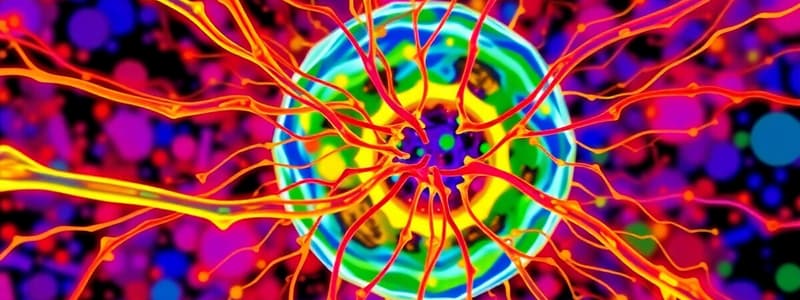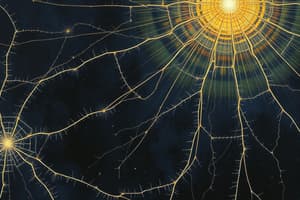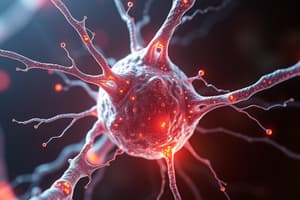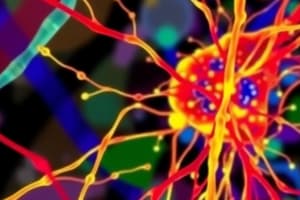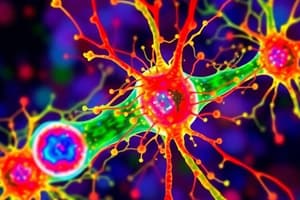Podcast
Questions and Answers
What is the primary effect of hydrolysis on microtubules?
What is the primary effect of hydrolysis on microtubules?
- It promotes polymerization at the minus (-) end.
- It maintains microtubule stability by enhancing the GTP cap.
- It increases the length and dynamism of microtubules.
- It results in longer and less dynamic microtubules. (correct)
Which factor is involved in promoting microtubule shrinkage?
Which factor is involved in promoting microtubule shrinkage?
- Dynein
- GTP cap
- Tubulin
- Kinesin-13 (correct)
How is the stability of a microtubule primarily maintained?
How is the stability of a microtubule primarily maintained?
- By the presence of a stable GTP cap at the plus (+) end. (correct)
- By increasing the rate of tubulin dimer incorporation.
- Through the action of dynein motors.
- By a dynamic assembly process at the minus (-) end.
What happens if the GTP cap of a microtubule is lost?
What happens if the GTP cap of a microtubule is lost?
What is the relationship between hydrolysis and the structural integrity of microtubules?
What is the relationship between hydrolysis and the structural integrity of microtubules?
What is the primary outcome of destabilizing MAPs on microtubules?
What is the primary outcome of destabilizing MAPs on microtubules?
Which condition favors the polymerization of tubulin-GTP dimers?
Which condition favors the polymerization of tubulin-GTP dimers?
What role do microtubules play in cellular transport?
What role do microtubules play in cellular transport?
What does the regulation of tubulin polymerization primarily determine?
What does the regulation of tubulin polymerization primarily determine?
Destabilizing MAPs primarily affect which part of the microtubule structure?
Destabilizing MAPs primarily affect which part of the microtubule structure?
What happens when the concentration of tubulin-GTP dimers is lower than the hydrolysis rate?
What happens when the concentration of tubulin-GTP dimers is lower than the hydrolysis rate?
Which of the following accurately describes a function of microtubules?
Which of the following accurately describes a function of microtubules?
What characterizes dynamic instability in microtubules?
What characterizes dynamic instability in microtubules?
What is the arrangement of the microtubule doublets in cilia and flagella?
What is the arrangement of the microtubule doublets in cilia and flagella?
Which component is responsible for linking adjacent microtubule doublets?
Which component is responsible for linking adjacent microtubule doublets?
How many protofilaments are arranged in each microtubule structure?
How many protofilaments are arranged in each microtubule structure?
What type of movement is converted into bending due to the structure of microtubules?
What type of movement is converted into bending due to the structure of microtubules?
What is the basic structural composition of a microtubule?
What is the basic structural composition of a microtubule?
What is an essential characteristic of each tubulin dimer in microtubules?
What is an essential characteristic of each tubulin dimer in microtubules?
What structure is formed by the arrangement of 2 central singlet microtubules?
What structure is formed by the arrangement of 2 central singlet microtubules?
What role does nexin play in the interaction of microtubules?
What role does nexin play in the interaction of microtubules?
What is the primary role of the γ-tubulin ring complex in microtubule formation?
What is the primary role of the γ-tubulin ring complex in microtubule formation?
Which of the following best describes labile microtubules?
Which of the following best describes labile microtubules?
What is one of the main functions of stable microtubules?
What is one of the main functions of stable microtubules?
Which cellular structure is identified as the site for nucleation of microtubules?
Which cellular structure is identified as the site for nucleation of microtubules?
Which of the following statements about microtubules is FALSE?
Which of the following statements about microtubules is FALSE?
What structural components do labile microtubules connect to?
What structural components do labile microtubules connect to?
How does the γ-tubulin ring complex contribute to microtubule function?
How does the γ-tubulin ring complex contribute to microtubule function?
What function does the microtubule stability primarily serve?
What function does the microtubule stability primarily serve?
What characteristic of microtubules allows them to adapt quickly to cellular needs?
What characteristic of microtubules allows them to adapt quickly to cellular needs?
Which component is crucial for the growth of microtubules?
Which component is crucial for the growth of microtubules?
What happens to microtubules during the process described as 'shrinkage'?
What happens to microtubules during the process described as 'shrinkage'?
In the context of cellular structure, what role do microtubules primarily serve?
In the context of cellular structure, what role do microtubules primarily serve?
What mechanism resumes growth after a shrinkage phase in microtubules?
What mechanism resumes growth after a shrinkage phase in microtubules?
What is the significance of dynamic instability in microtubules?
What is the significance of dynamic instability in microtubules?
Which statement best describes the relationship between tubulin-GTP and microtubule dynamics?
Which statement best describes the relationship between tubulin-GTP and microtubule dynamics?
What describes the cyclical nature of microtubule behavior?
What describes the cyclical nature of microtubule behavior?
What is the main role of motor proteins in cellular processes?
What is the main role of motor proteins in cellular processes?
Which structure serves as the primary microtubule-organizing center in animal cells?
Which structure serves as the primary microtubule-organizing center in animal cells?
What occurs during the process of treadmilling in microtubules?
What occurs during the process of treadmilling in microtubules?
What is the arrangement of microtubules in centrioles?
What is the arrangement of microtubules in centrioles?
What phenomenon describes the transition from microtubule polymerization to depolymerization?
What phenomenon describes the transition from microtubule polymerization to depolymerization?
How do dyneins and kinesins differ in their function?
How do dyneins and kinesins differ in their function?
What can lead to depolymerization in microtubules?
What can lead to depolymerization in microtubules?
Which of the following best describes the term 'MTOC'?
Which of the following best describes the term 'MTOC'?
In which type of cell is the dynamic behavior of microtubules crucial for searching chromosomes during division?
In which type of cell is the dynamic behavior of microtubules crucial for searching chromosomes during division?
Which description best fits catastrophe in the context of microtubule dynamics?
Which description best fits catastrophe in the context of microtubule dynamics?
What is typically the concentration relationship that leads to depolymerization?
What is typically the concentration relationship that leads to depolymerization?
What does the term 'pericentriolar material' refer to?
What does the term 'pericentriolar material' refer to?
Which statement accurately describes the process of microtubule assembly?
Which statement accurately describes the process of microtubule assembly?
Flashcards
Hydrolysis
Hydrolysis
The process of breaking down a molecule by adding water.
Dehydration Synthesis
Dehydration Synthesis
The process of building up a molecule by removing water.
Microtubule Polymerization Factor
Microtubule Polymerization Factor
A protein that promotes the growth of microtubules.
Microtubule Depolymerization Factor
Microtubule Depolymerization Factor
Signup and view all the flashcards
GTP Cap
GTP Cap
Signup and view all the flashcards
Nexin Bridges
Nexin Bridges
Signup and view all the flashcards
9+2 arrangement
9+2 arrangement
Signup and view all the flashcards
Tubulin Dimer
Tubulin Dimer
Signup and view all the flashcards
Protofilaments
Protofilaments
Signup and view all the flashcards
Microtubule structure in cilia and flagella.
Microtubule structure in cilia and flagella.
Signup and view all the flashcards
Central Singlet Microtubules
Central Singlet Microtubules
Signup and view all the flashcards
GTP binding to tubulin dimers.
GTP binding to tubulin dimers.
Signup and view all the flashcards
Microtubule structure
Microtubule structure
Signup and view all the flashcards
Labile Microtubules
Labile Microtubules
Signup and view all the flashcards
γ-TuRC (Gamma-Tubulin Ring Complex)
γ-TuRC (Gamma-Tubulin Ring Complex)
Signup and view all the flashcards
Microtubule Nucleation
Microtubule Nucleation
Signup and view all the flashcards
Microtubule Stability
Microtubule Stability
Signup and view all the flashcards
Cytoskeleton
Cytoskeleton
Signup and view all the flashcards
Microtubule-Organizing Centers (MTOCs)
Microtubule-Organizing Centers (MTOCs)
Signup and view all the flashcards
Centrosome
Centrosome
Signup and view all the flashcards
Tubulin
Tubulin
Signup and view all the flashcards
Destabilizing MAPs
Destabilizing MAPs
Signup and view all the flashcards
Transport of Cellular Cargo
Transport of Cellular Cargo
Signup and view all the flashcards
Microtubule Polymerization
Microtubule Polymerization
Signup and view all the flashcards
Microtubule Depolymerization
Microtubule Depolymerization
Signup and view all the flashcards
Tubulin-GTP Concentration
Tubulin-GTP Concentration
Signup and view all the flashcards
Microtubule-Associated Proteins (MAPs)
Microtubule-Associated Proteins (MAPs)
Signup and view all the flashcards
GTP Hydrolysis
GTP Hydrolysis
Signup and view all the flashcards
Microtubule Dynamics
Microtubule Dynamics
Signup and view all the flashcards
Dynamic Instability in Microtubules
Dynamic Instability in Microtubules
Signup and view all the flashcards
Microtubule Growth
Microtubule Growth
Signup and view all the flashcards
Microtubule Shrinkage
Microtubule Shrinkage
Signup and view all the flashcards
Plus End of a Microtubule
Plus End of a Microtubule
Signup and view all the flashcards
Minus End of a Microtubule
Minus End of a Microtubule
Signup and view all the flashcards
Depolymerization
Depolymerization
Signup and view all the flashcards
Motor Protein
Motor Protein
Signup and view all the flashcards
Kinesin
Kinesin
Signup and view all the flashcards
Dynein
Dynein
Signup and view all the flashcards
Centriole
Centriole
Signup and view all the flashcards
Treadmilling
Treadmilling
Signup and view all the flashcards
Polymerization
Polymerization
Signup and view all the flashcards
Catastrophe
Catastrophe
Signup and view all the flashcards
Rescue
Rescue
Signup and view all the flashcards
Microtubule Stabilizer
Microtubule Stabilizer
Signup and view all the flashcards
Microtubule Destabilizer
Microtubule Destabilizer
Signup and view all the flashcards
Intracellular Transport
Intracellular Transport
Signup and view all the flashcards
Mitosis
Mitosis
Signup and view all the flashcards
Organelle Positioning
Organelle Positioning
Signup and view all the flashcards
Study Notes
Microtubules: Structure and Organization
- Microtubules are a type of protein filament in the eukaryotic cytoskeleton
- Diameter: 25nm
- Hollow cylinders made of tubulin dimers
- Rigid and dynamic, nucleated
- Involved in intracellular transport, cell division (spindle formation), and structural support
- Composed of 13 protofilaments arranged in a ring-like structure
- Made of α-tubulin and β-tubulin dimers
- Plus (+) end: Rapid growth, toward cell periphery
- Minus (-) end: Depolymerizes rapidly, anchored to the centrosome (MTOC)
- Each tubulin dimer binds to GTP for polymerization
Microtubule Assembly
- Nucleation: Initiated by γ-tubulin ring complex (γ-TuRC) at the centrosome.
- Polymerization: Tubulin-GTP binds, adding dimers to the protofilament. A GTP cap at the (+) end stabilizes growth. GTP on β-tubulin hydrolyzes to GDP post-assembly.
- Hydrolysis: The microtubule's stability is maintained by a GTP cap at the plus (+) end. If lost, depolymerization results.
Dynamic Behavior
- Microtubules show cycles of growth and shrinkage
- Catastrophe: Transition from polymerization to depolymerization due to GTP cap loss.
- Rescue: Growth resumes with added tubulin-GTP subunits.
- Treadmilling: Addition at (+) end, removal at (-) end, maintaining constant length
- Dynamic Instability: Polymerization > GTP hydrolysis rate results in polymerization; opposite for depolymerization. This allows for rapid cytoskeleton reorganization.
Microtubule-Associated Proteins (MAPs)
- Stabilizing MAPS: Enhance stability, suppress depolymerization; eg, MAP2 & Tau. Result in longer, less dynamic MTs.
- Destabilizing MAPS: Disrupt integrity; eg, Kinesin-13; result in shorter, more dynamic MTs.
- Motor MAPS: Kinesins (toward (+) end) and Dyneins (toward (-) end) drive intracellular transport
Cilia and Flagella
- Projections from the plasma membrane
- Supported by microtubules
- Cilia: Particle movement (e.g., mucus transport)
- Flagella: Cell locomotion (e.g., sperm cells)
- 9 peripheral doublets (A & B microtubules)
- 2 central singlet microtubules
- Nexin bridges connect microtubules
- Dynein arms drive movement along neighboring microtubules; ATP hydrolysis is involved
- Axoneme is the core structure.
Centrosome
- Microtubule-organizing center (MTOC) in animal cells
- Two perpendicular centrioles surrounded by pericentriolar material
- Centrioles: 9 triplets of microtubules (9+0 pattern)
Studying That Suits You
Use AI to generate personalized quizzes and flashcards to suit your learning preferences.
